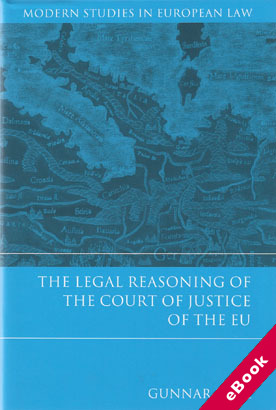
The device(s) you use to access the eBook content must be authorized with an Adobe ID before you download the product otherwise it will fail to register correctly.
For further information see https://www.wildy.com/ebook-formats
Once the order is confirmed an automated e-mail will be sent to you to allow you to download the eBook.
All eBooks are supplied firm sale and cannot be returned. If you believe there is a fault with your eBook then contact us on ebooks@wildy.com and we will help in resolving the issue. This does not affect your statutory rights.
The Court of Justice has often been characterised both as a motor of integration and a judicial law-maker. To what extent is this a fair description of the Court's jurisprudence over more than half a century?
The book is divided into two parts. Part one develops a new heuristic theory of legal reasoning which argues that legal uncertainty is a pervasive and inescapable feature of primary legal material and judicial reasoning alike, which has its origin in a combination of linguistic vagueness, value pluralism and rule instability associated with precedent. Part two examines the jurisprudence of the Court of Justice of the EU against this theoretical framework.
The author demonstrates that the ECJ's interpretative reasoning is best understood in terms of a tripartite approach whereby the Court justifies its decisions in terms of the cumulative weight of purposive, systemic and literal arguments. That approach is more in line with orthodox legal reasoning in other legal systems than is commonly acknowledged and differs from the approach of other higher, especially constitutional courts only in degree.
It nevertheless leaves the Court considerable discretion in determining the relative weight and ranking of the various interpretative criteria from one case to another.
The Court's exercise of its discretion is best understood in terms of the constraints imposed by the accepted justificatory discourse and certain extra-legal steadying factors of legal reasoning, which include a range of political factors such as sensitivity to Member States' interests, political fashion and deference to the 'EU legislator'.
In conclusion, case law analysis across most areas of EU law suggests that the ECJ has used the flexibility in its tripartite approach to resolve legal uncertainty in the EU primary materials in a broadly communautaire fashion subject, however, to i.) regard to the political, constitutional and budgetary sensitivities of Member States, ii.) depending on the constraints and extent of interpretative manoeuvre afforded by the degree of linguistic vagueness of the provisions in question, the relative status of and degree of potential conflict between the applicable norms, and the range and clarity of the interpretative topoi available to resolve first-order legal uncertainty, and, finally, iii.) bearing in mind the largely unpredictable personal element in all adjudication.